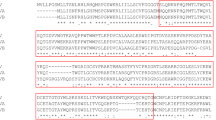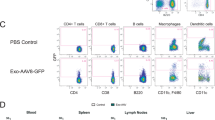Abstract
In contrast to murine leukaemia virus (MLV)-derived vector systems, vector particles derived from the avian spleen necrosis virus (SNV) have been successfully targeted to subsets of human cells by envelope modification with antibody fragments (scFv). However, an in vivo application of the SNV vector system in gene transfer protocols is hampered by its lack of resistance against human complement. To overcome this limitation we established pseudotyping of MLV vector particles produced in human packaging cell lines with the SNV envelope (Env) protein. Three variants of SNV Env proteins differing in the length of their cytoplasmic domains were all efficiently incorporated into MLV core particles. These pseudotype particles infected the SNV permissive cell line D17 at titers of up to 105 IU/ml. A stable packaging cell line (MS4) of human origin released MLV(SNV) pseudoype vectors that were resistant against human complement inactivation. To redirect their tropism to human T cells, MS4 cells were transfected with the expression gene encoding the scFv 7A5 in fusion with the transmembrane domain (TM) of the SNV Env protein, previously shown to retarget SNV vector particles to human lymphocytes. MLV(SNV-7A5)-vector particles released from these cells were selectively infectious for human T cell lines. The data provide a proof of principle for targeting MLV-derived vectors to subpopulations of human cells through pseudotyping with SNV targeting envelopes.
This is a preview of subscription content, access via your institution
Access options
Subscribe to this journal
Receive 12 print issues and online access
$259.00 per year
only $21.58 per issue
Buy this article
- Purchase on Springer Link
- Instant access to full article PDF
Prices may be subject to local taxes which are calculated during checkout




Similar content being viewed by others
References
Buchholz CJ, Stitz J, Cichutek, K . Retroviral cell targeting vectors Curr Opin Mol Ther 1999 1: 613–621
Cosset FL, Russell SJ . Targeting retrovirus entry Gene Therapy 1996 3: 946–956
Cosset FL et al. Retroviral retargeting by envelopes expressing an N-terminal binding domain J Virol 1995 69: 6314–6321
Martin F et al. Retrovirus targeting by tropism restriction to melanoma cells J Virol 1999 73: 6923–6929
Benedict CA, et al. Targeting retroviral vectors to CD34-expressing cells: binding to CD34 does not catalyse virus–cell fusion Hum Gene Ther 1999 10: 545–557
Peng KW, Vile R, Cosset FL, Russell S . Selective transduction of protease-rich tumors by matrix-metalloproteinase-targeted retroviral vectors Gene Therapy 1999 6: 1552–1557
Buchholz CJ et al. In vivo selection of protease cleavage sites from retrovirus display libraries Nature Biotech 1998 16: 951–954
Chu TH, Dornburg R . Toward highly efficient cell-type-specific gene-transfer with retroviral vectors displaying single-chain antibodies J Virol 1997 71: 720–725
Jiang A et al. Cell-type specific gene transfer into human cells with retroviral vectors that display single-chain antibodies J Virol 1998 72: 10148–10156
Engelstadter M et al. Targeting human T cells by retroviral vectors displaying antibody domains selected from a phage display library Hum Gene Ther 2000 11: 293–303
Takeuchi T et al. Type C retrovirus inactivation by human complement is determined by both the viral genome and the producer cell J Virol 1994 68: 8001–8007
Cosset FL et al. High-titer packaging cells producing recombinant retroviruses resistant to human serum J Virol 1995 69: 7430–7436
Pensiero MN, Wysocki CA, Nader K, Kikuchi GE . Development of amphotropic murine retrovirus vectors resistant to inactivation by human serum Hum Gene Ther 1996 7: 1095–1101
DePolo NJ et al. The resistance of retroviral vectors produced from human cells to serum inactivation in vivo and in vitro is primate species dependent J Virol 1999 73: 6708–6714
Koo HM et al. Reticuloendotheliosis type C and primate type D oncoretroviruses are members of the same receptor interference group J Virol 1992 66: 3448–3454
Schnierle BS et al. Pseudotyping of murine leukemia virus with the envelope glycoproteins of HIV generates a retroviral vector with specificity of infection for CD4-expressing cells Proc Natl Acad Sci USA 1997 94: 8640–8645
Stitz J et al. Lentiviral vectors pseudotyped with envelope glycoproteins derived from gibbon ape leukemia virus and murine leukemia virus 10A1 Virology 2000 273: 16–20
Stitz J et al. MLV-derived retroviral vectors selective for CD4-expressing cells and resistant to neutralization by sera from HIV-infected patients Virology 2000 267: 229–236
Soneoka Y et al. A transient three-plasmid expression system for the production of high titer retroviral vectors Nucleic Acids Res 1995 23: 628–633
Ragheb JA, Anderson WF . pH-independent murine leukemia virus ecotropic envelope-mediated cell fusion: implications for the role of the R peptide and p12E TM in viral entry J Virol 1994 68: 3220–3231
Stitz J, Buchholz CJ, Cichutek K . MLV-derived retroviral pseudotype vectors Gene Ther Reg 2000 1: 177–192
Mammano F et al. Truncation of the human immunodeficiency virus type 1 envelope glycoprotein allows efficient pseudotyping of Moloney murine leukemia virus particles and gene transfer into CD4+ cells J Virol 1997 71: 3341–3345
Lindemann D, Bock M, Schweizer M, Rethwilm A . Efficient pseudotyping of murine leukemia virus particles with chimeric human foamy virus envelope proteins J Virol 1997 71: 4815–4820
Fielding AK et al. A hyperfusogenic gibbon ape leukemia envelope glycoprotein: targeting of a cytotoxic gene by ligand display Hum Gene Ther 2000 11: 817–826
Martinez I, Dornburg R . Improved retroviral packaging cell lines derived from spleen necrosis virus Virology 1995 208: 234–241
Cui ZZ et al. Monoclonal antibodies against avian reticuloendotheliosis virus: identification of strain-specific and strain-common epitopes J Immunol 1986 136: 4237–4242
Acknowledgements
The authors are grateful to M Selbert and R Wenig for excellent technical support, to L Lee (Regional Poultry Research Laboratory, East Lansing, MI, USA) for providing 11A25 antibody and to R Dornburg (Philadelphia) for the kind donation of DSH-cxl cells, to FL Cosset (Lyon) for kindly providing TelCeb6 cells and plasmid pMFGnlslacZ. This work was supported by grant No. 328–135000/03 from the Federal Ministry of Health to KC.
Author information
Authors and Affiliations
Rights and permissions
About this article
Cite this article
Engelstädter, M., Buchholz, C., Bobkova, M. et al. Targeted gene transfer to lymphocytes using murine leukaemia virus vectors pseudotyped with spleen necrosis virus envelope proteins. Gene Ther 8, 1202–1206 (2001). https://doi.org/10.1038/sj.gt.3301500
Received:
Accepted:
Published:
Issue Date:
DOI: https://doi.org/10.1038/sj.gt.3301500



